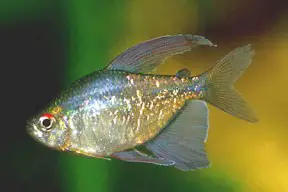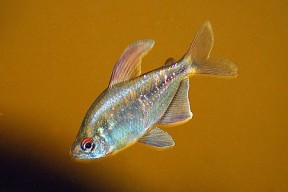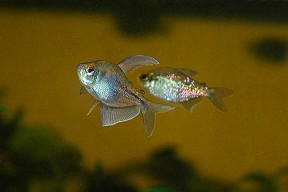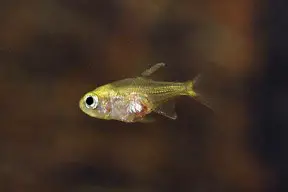Moenkhausia pittieri
Diamond Tetra
Classification
Characidae
Distribution
Endemic to Lake Valencia and surrounding waters, Venezuela.
Habitat
Lake Valencia is situated between two mountain ranges and is Venezuela’s second largest lake. Water quality is generally very poor, mainly due to pollution from human agricultural and industrial activity. As such it’s prone to regular eutrophication events and associated algal blooms. Scientific studies have shown that fish species diversity dropped by almost 60% during the mid to late twentieth century. The diamond tetra is found in shallow, vegetated parts of the lake, as well as in several slow-moving tributaries. Most of the fish sold in the trade are mass-bred on commercial farms in Eastern Europe or the Far East, though.
Maximum Standard Length
2.4″ (6cm).
Aquarium SizeTop ↑
A small group would need a tank around 24″ x 15″ x 12″ (60cm x 37.5cm x 30cm) – 70 litres in size.
Maintenance
Quite an adaptable species that will thrive in most well-maintained tanks, although it doesn’t like very brightly lit or sparsely decorated environments. It looks excellent in a densely planted tank, where it will develop some really intense colours.
It can also be kept in an Amazonian biotope setup if you wish. Use a substrate of river sand and add a few driftwood branches (if you can’t find driftwood of the desired shape, common beech is safe to use if thoroughly dried and stripped of bark) and twisted roots. A few handfuls of dried leaves (again beech can be used, or oak leaves are also suitable) would complete the natural feel. Allow the wood and leaves to stain the water the colour of weak tea, removing old leaves and replacing them every few weeks so they don’t rot and foul the water. The lighting should be fairly dim in this kind of setup.
Water Conditions
Temperature: 75 to 82°F (24 to 28°C)
pH: 5.5 to 7.0. Most tank-bred specimens will survive in alkaline water, but will show their best colours when maintained at a pH below neutral.
Hardness: 5 to 12°H
Diet
Easy to feed. It will readily accept just about anything offered. For the best condition and colours offer regular meals of small live and frozen foods such as bloodworm, Daphnia and brine shrimp, along with dried flakes and granules.
Behaviour and CompatibilityTop ↑
A good choice for the ‘general’ community setup. It’s quite colourful, peaceful and males grow to an impressive size for a tetra. It’s a good tankmate for most livebearers, danionins, rasboras, other tetras and peaceful bottom dwellers such as Corydoras or smaller Loricariids. It can also be kept with the majority of commonly available gouramis and dwarf cichlids. Due to its rounded shape and adult size it can also be used as a dither for non-aggressive, medium-sized cichlids such as discus or Geophagus species.
Although it has a reputation as a bit of a fin nipper, this behaviour can usually be rectified by keeping it in a small shoal of at least 6-8 specimens. When maintained in these kind of numbers any squabbling is generally contained within the group. As with almost all tetras, it fares better in the presence of conspecifics anyway, and tends to be a little skittish if kept in insufficient numbers. You’ll also see some stunning displays between rival males if several are kept.
Sexual Dimorphism
Males tend to be larger and less stockily built than females, with a greater proportion of the reflective scales that give the species its common name. They also develop beautiful, extended ventral, dorsal and anal fins as they mature. These are suffused with a violet sheen, while those of the female are almost entirely clear.
Reproduction
Can be spawned in a similar way to many other tetras. You’ll need to set up a separate tank in which to do so if you want to raise fry in any great numbers. Something around 18″ x 12″ x 12″ in size is fine. Use very dim lighting and add clumps of fine-leaved plants such as java moss or spawning mops, to give the fish somewhere to deposit their eggs. Alternatively you could cover the base of the tank with some kind of mesh. This should be of a large enough grade so that the eggs can fall through it, but small enough so that the adults cannot reach them. The water should be soft and acidic in the range pH 5.5-6.5, gH 1-5, with a temperature of around 80-84°F. Filtering the water through peat is useful, as is the use of RO water. A small air-powered sponge filter bubbling away very gently is all that is needed in terms of filtration.
It can be spawned in a group, with half a dozen specimens of each sex being a good number. Condition these with plenty of small live foods and spawning should not present too many problems.
Alternatively it can be spawned in pairs. Under this technique the fish are conditioned in male and female groups in separate tanks. When the females are noticeably full of eggs and the males are displaying their best colours, select the fattest female and best-coloured male and transfer them to the spawning tank in the evening. They should spawn the following morning.
In either situation the adults will eat the eggs given the chance and should be removed as soon as eggs are noticed. These will hatch in 24-36 hours, with the fry becoming free swimming a 3-4 days later. They should be fed on an infusoria–type food for the first few days, until they are large enough to accept microworm or brine shrimp nauplii.
NotesTop ↑
This species is something of an “ugly duckling”, as it’s usually sold as a fairly bland looking, silvery juvenile. Given time and a good diet it develops into a magnificent fish as an adult, that really does sparkle like a diamond. A big shoal of these in a planted tank looks stunning.
The taxonomic status of all species in the genus Moenkhausia is currently Incertae Sedis, meaning uncertain. The genus is currently used as something of a catch-all for a large number of small characin species. Most experts agree that a full revision is required, with the likely outcome that many of these will be placed into new or different genera.





